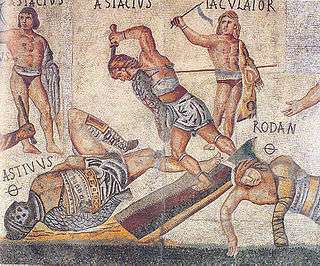Gladiator Mosaic
The Gladiator Mosaic is a famous mosaic of gladiators measuring about 28 meters,[1] dated to the first half of the 4th century. It was discovered in 1834 on the Borghese estate at Torrenova, on the Via Casilina outside Rome.[1] The antiquities which reinvigorated the Borghese Collection after it had shrunk following the sale of much of the collection to Napoleon I.

Detail of the Gladiator Mosaic.
The name of each gladiator depicted is given in inscription next to the figure, with a ∅-shaped symbol (possibly the Greek letter Θ, theta nigrum, for θάνατος "dead")[2] marking the names of gladiators who died in combat. The inscription is listed as CIL VI 10206.
Inscription
- Licentiosus/ [------]// Purpureus/ Entinus/ Baccibus// Astacius// Astacius/ Astivus ∅ // Iaculator// [------]/ Rodan[---] ∅ // Melitio// Talamonius/ Aureus ∅ // Cupido ∅ / Bellerefons// [------]/ Pampineus// PI[---]// Arius// Eliacer// Melea[ger(?)]/ [------]// [---]us vic(it)// Mazicinus/ Alumnus vic(it)// Ideus r(e)t(iarius)// Callimorfus/ Mazicinus// [---]us vic(it)/ Callimorfus// Serpeneus// Sabatius
- Astacius, Astivus, Rodan, Belleronfons, Cupido, Aurius, Alumnus, Serpeniius, Meliio, Mazicinus[2]
References
- "Gladiator Mosaics". mosaicmarble.com. Retrieved 2018-04-05.
- "The Mosaic of the Gladiator: fighting to the death | Italian Ways". www.italianways.com. Retrieved 2018-04-05.
| Wikimedia Commons has media related to Gladiator Mosaic (Rome). |
This article is issued from Wikipedia. The text is licensed under Creative Commons - Attribution - Sharealike. Additional terms may apply for the media files.